BUSN1009 - Quantitative Methods: Probability Distributions Analysis
VerifiedAdded on 2023/06/08
|10
|1995
|133
Homework Assignment
AI Summary
This assignment provides detailed solutions to several problems related to quantitative methods, focusing on binomial and normal probability distributions. It includes calculations for binomial probabilities given different values of n and p, such as finding P(x = 12), P(x > 8), P(x < 12), and P(4 ≤ x ≤ 9). The assignment also covers normal distribution problems, calculating probabilities for various scenarios, including finding the probability of a value being less than, greater than, or between specified limits. Furthermore, it addresses problems related to real-world scenarios such as the proportion of students studying marketing or international business, the weights of eggs, and the distribution of home mortgages in New Zealand, providing a comprehensive overview of how to apply these statistical methods. Desklib is a platform where students can find similar solved assignments and past papers.
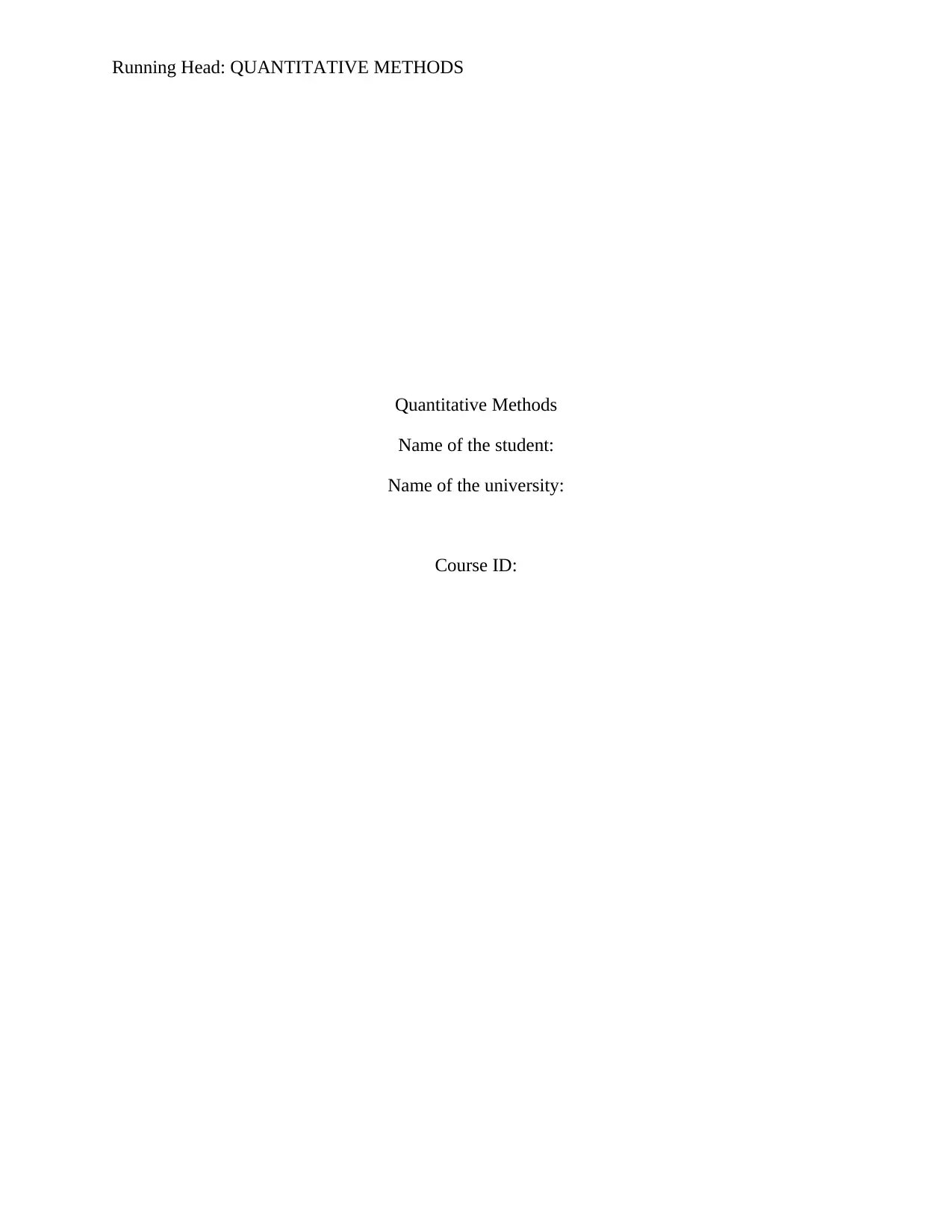
Running Head: QUANTITATIVE METHODS
Quantitative Methods
Name of the student:
Name of the university:
Course ID:
Quantitative Methods
Name of the student:
Name of the university:
Course ID:
Paraphrase This Document
Need a fresh take? Get an instant paraphrase of this document with our AI Paraphraser
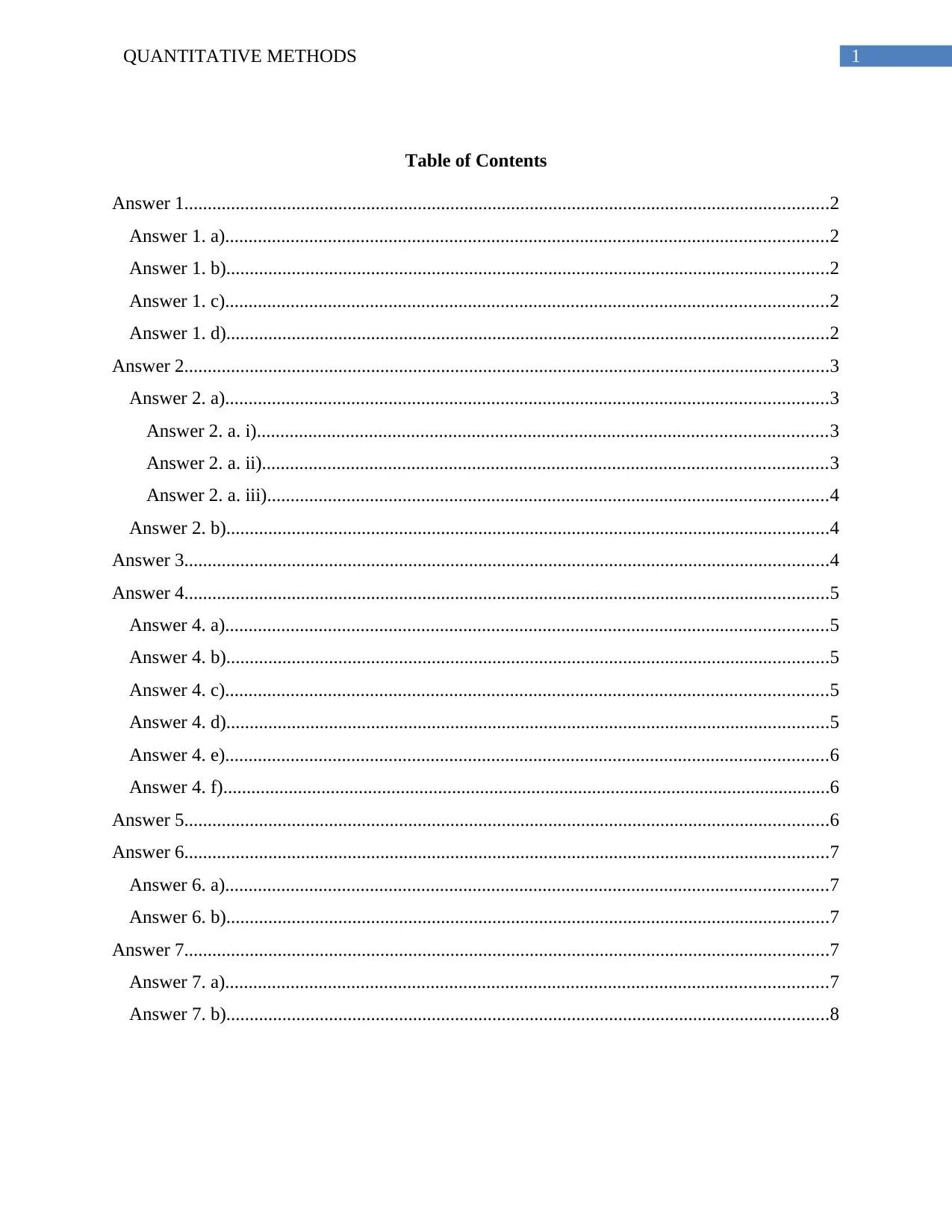
QUANTITATIVE METHODS 1
Table of Contents
Answer 1..........................................................................................................................................2
Answer 1. a).................................................................................................................................2
Answer 1. b).................................................................................................................................2
Answer 1. c).................................................................................................................................2
Answer 1. d).................................................................................................................................2
Answer 2..........................................................................................................................................3
Answer 2. a).................................................................................................................................3
Answer 2. a. i)..........................................................................................................................3
Answer 2. a. ii).........................................................................................................................3
Answer 2. a. iii)........................................................................................................................4
Answer 2. b).................................................................................................................................4
Answer 3..........................................................................................................................................4
Answer 4..........................................................................................................................................5
Answer 4. a).................................................................................................................................5
Answer 4. b).................................................................................................................................5
Answer 4. c).................................................................................................................................5
Answer 4. d).................................................................................................................................5
Answer 4. e).................................................................................................................................6
Answer 4. f)..................................................................................................................................6
Answer 5..........................................................................................................................................6
Answer 6..........................................................................................................................................7
Answer 6. a).................................................................................................................................7
Answer 6. b).................................................................................................................................7
Answer 7..........................................................................................................................................7
Answer 7. a).................................................................................................................................7
Answer 7. b).................................................................................................................................8
Table of Contents
Answer 1..........................................................................................................................................2
Answer 1. a).................................................................................................................................2
Answer 1. b).................................................................................................................................2
Answer 1. c).................................................................................................................................2
Answer 1. d).................................................................................................................................2
Answer 2..........................................................................................................................................3
Answer 2. a).................................................................................................................................3
Answer 2. a. i)..........................................................................................................................3
Answer 2. a. ii).........................................................................................................................3
Answer 2. a. iii)........................................................................................................................4
Answer 2. b).................................................................................................................................4
Answer 3..........................................................................................................................................4
Answer 4..........................................................................................................................................5
Answer 4. a).................................................................................................................................5
Answer 4. b).................................................................................................................................5
Answer 4. c).................................................................................................................................5
Answer 4. d).................................................................................................................................5
Answer 4. e).................................................................................................................................6
Answer 4. f)..................................................................................................................................6
Answer 5..........................................................................................................................................6
Answer 6..........................................................................................................................................7
Answer 6. a).................................................................................................................................7
Answer 6. b).................................................................................................................................7
Answer 7..........................................................................................................................................7
Answer 7. a).................................................................................................................................7
Answer 7. b).................................................................................................................................8
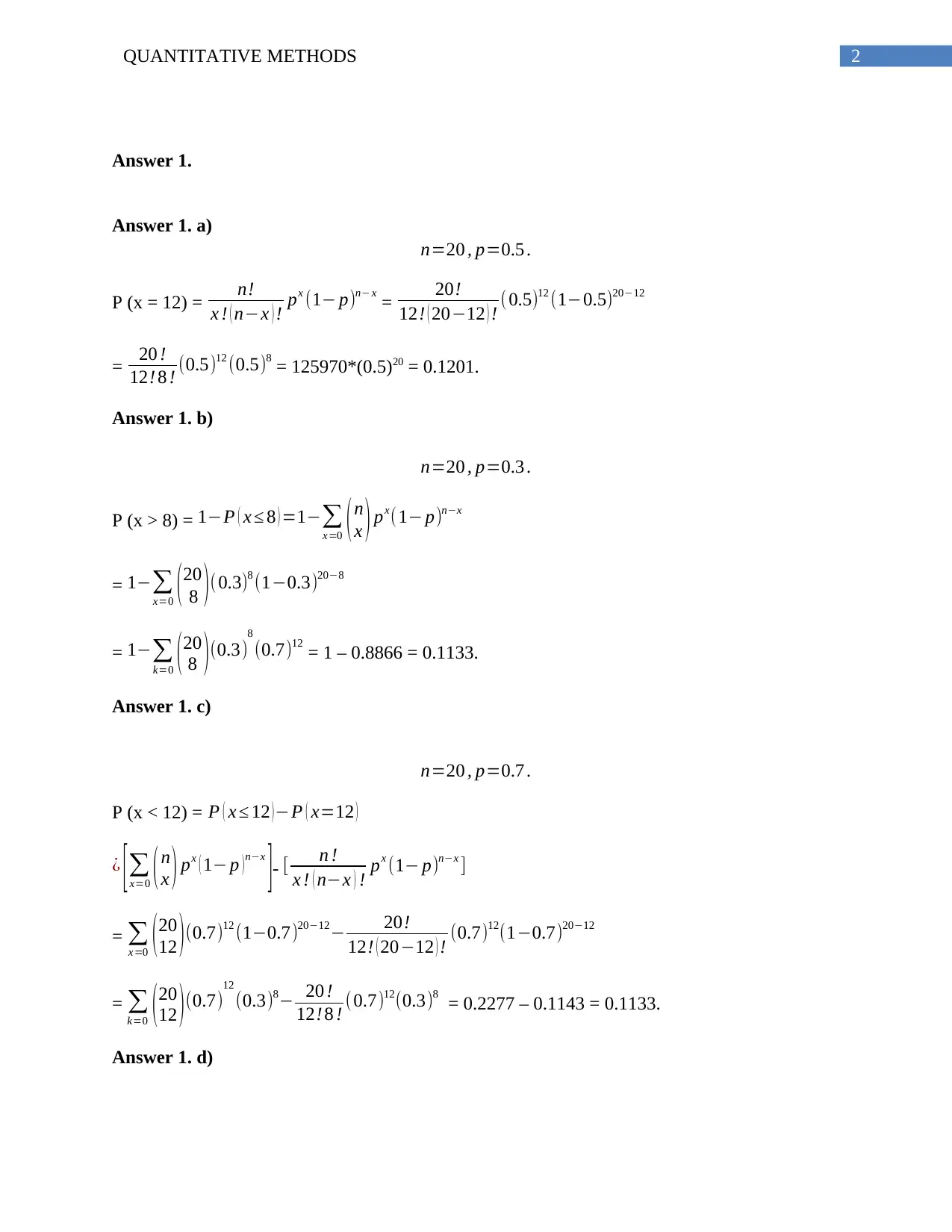
2QUANTITATIVE METHODS
Answer 1.
Answer 1. a)
n=20 , p=0.5 .
P (x = 12) = n!
x ! ( n−x ) ! px (1− p)n− x
= 20!
12! ( 20−12 ) ! (0.5)12 (1−0.5)20−12
= 20 !
12! 8 ! (0.5)12 (0.5)8
= 125970*(0.5)20 = 0.1201.
Answer 1. b)
n=20 , p=0.3 .
P (x > 8) = 1−P ( x ≤ 8 ) =1−∑
x=0 ( n
x ) px(1− p)n−x
= 1−∑
x=0 ( 20
8 ) (0.3)8 (1−0.3)20−8
= 1−∑
k=0 (20
8 )(0.3)8
(0.7)12
= 1 – 0.8866 = 0.1133.
Answer 1. c)
n=20 , p=0.7 .
P (x < 12) = P ( x ≤ 12 )−P ( x=12 )
¿ [ ∑
x=0 ( n
x ) px ( 1− p ) n−x
]- [ n !
x ! ( n−x ) ! px (1− p)n−x ]
= ∑
x=0 (20
12 )(0.7)12 (1−0.7)20−12− 20!
12! ( 20−12 ) ! (0.7)12(1−0.7)20−12
= ∑
k=0 ( 20
12 ) (0.7)12
(0.3)8− 20 !
12! 8 ! (0.7)12(0.3)8
= 0.2277 – 0.1143 = 0.1133.
Answer 1. d)
Answer 1.
Answer 1. a)
n=20 , p=0.5 .
P (x = 12) = n!
x ! ( n−x ) ! px (1− p)n− x
= 20!
12! ( 20−12 ) ! (0.5)12 (1−0.5)20−12
= 20 !
12! 8 ! (0.5)12 (0.5)8
= 125970*(0.5)20 = 0.1201.
Answer 1. b)
n=20 , p=0.3 .
P (x > 8) = 1−P ( x ≤ 8 ) =1−∑
x=0 ( n
x ) px(1− p)n−x
= 1−∑
x=0 ( 20
8 ) (0.3)8 (1−0.3)20−8
= 1−∑
k=0 (20
8 )(0.3)8
(0.7)12
= 1 – 0.8866 = 0.1133.
Answer 1. c)
n=20 , p=0.7 .
P (x < 12) = P ( x ≤ 12 )−P ( x=12 )
¿ [ ∑
x=0 ( n
x ) px ( 1− p ) n−x
]- [ n !
x ! ( n−x ) ! px (1− p)n−x ]
= ∑
x=0 (20
12 )(0.7)12 (1−0.7)20−12− 20!
12! ( 20−12 ) ! (0.7)12(1−0.7)20−12
= ∑
k=0 ( 20
12 ) (0.7)12
(0.3)8− 20 !
12! 8 ! (0.7)12(0.3)8
= 0.2277 – 0.1143 = 0.1133.
Answer 1. d)
You're viewing a preview
Unlock full access by subscribing today!
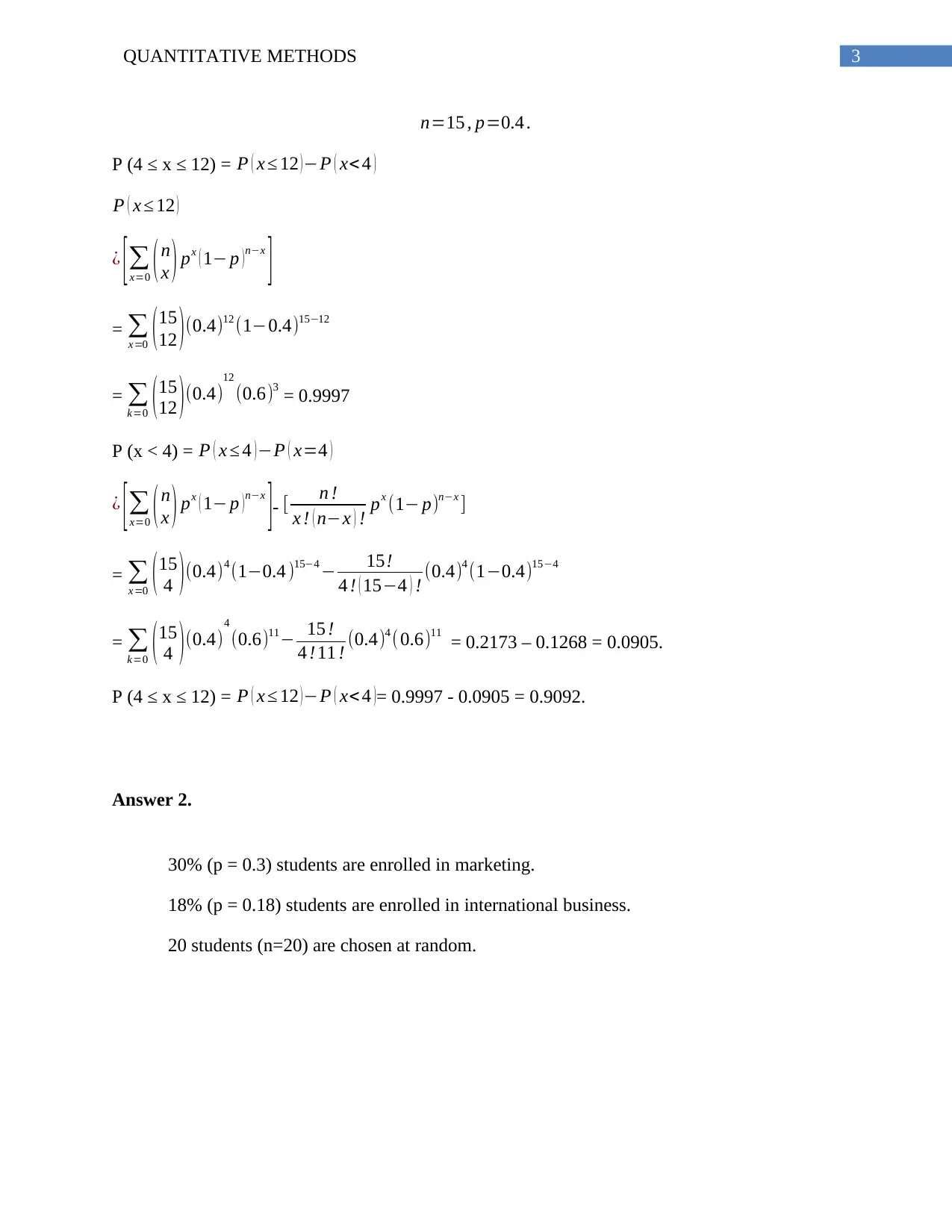
3QUANTITATIVE METHODS
n=15 , p=0.4 .
P (4 ≤ x ≤ 12) = P ( x ≤ 12 )−P ( x< 4 )
P ( x ≤ 12 )
¿ [ ∑
x=0 ( n
x ) px ( 1− p ) n−x
]
= ∑
x=0 ( 15
12 ) (0.4)12 (1−0.4)15−12
= ∑
k=0 (15
12 )(0.4)12
(0.6)3
= 0.9997
P (x < 4) = P ( x ≤ 4 ) −P ( x=4 )
¿ [ ∑
x=0 ( n
x ) px ( 1− p ) n−x
]- [ n !
x ! ( n−x ) ! px (1− p)n−x ]
= ∑
x=0 ( 15
4 ) (0.4)4 (1−0.4 )15−4 − 15!
4 ! ( 15−4 ) ! (0.4)4 (1−0.4)15−4
= ∑
k=0 (15
4 )(0.4)
4
(0.6)11− 15 !
4 ! 11 ! (0.4)4 (0.6)11
= 0.2173 – 0.1268 = 0.0905.
P (4 ≤ x ≤ 12) = P ( x ≤ 12 )−P ( x< 4 )= 0.9997 - 0.0905 = 0.9092.
Answer 2.
30% (p = 0.3) students are enrolled in marketing.
18% (p = 0.18) students are enrolled in international business.
20 students (n=20) are chosen at random.
n=15 , p=0.4 .
P (4 ≤ x ≤ 12) = P ( x ≤ 12 )−P ( x< 4 )
P ( x ≤ 12 )
¿ [ ∑
x=0 ( n
x ) px ( 1− p ) n−x
]
= ∑
x=0 ( 15
12 ) (0.4)12 (1−0.4)15−12
= ∑
k=0 (15
12 )(0.4)12
(0.6)3
= 0.9997
P (x < 4) = P ( x ≤ 4 ) −P ( x=4 )
¿ [ ∑
x=0 ( n
x ) px ( 1− p ) n−x
]- [ n !
x ! ( n−x ) ! px (1− p)n−x ]
= ∑
x=0 ( 15
4 ) (0.4)4 (1−0.4 )15−4 − 15!
4 ! ( 15−4 ) ! (0.4)4 (1−0.4)15−4
= ∑
k=0 (15
4 )(0.4)
4
(0.6)11− 15 !
4 ! 11 ! (0.4)4 (0.6)11
= 0.2173 – 0.1268 = 0.0905.
P (4 ≤ x ≤ 12) = P ( x ≤ 12 )−P ( x< 4 )= 0.9997 - 0.0905 = 0.9092.
Answer 2.
30% (p = 0.3) students are enrolled in marketing.
18% (p = 0.18) students are enrolled in international business.
20 students (n=20) are chosen at random.
Paraphrase This Document
Need a fresh take? Get an instant paraphrase of this document with our AI Paraphraser
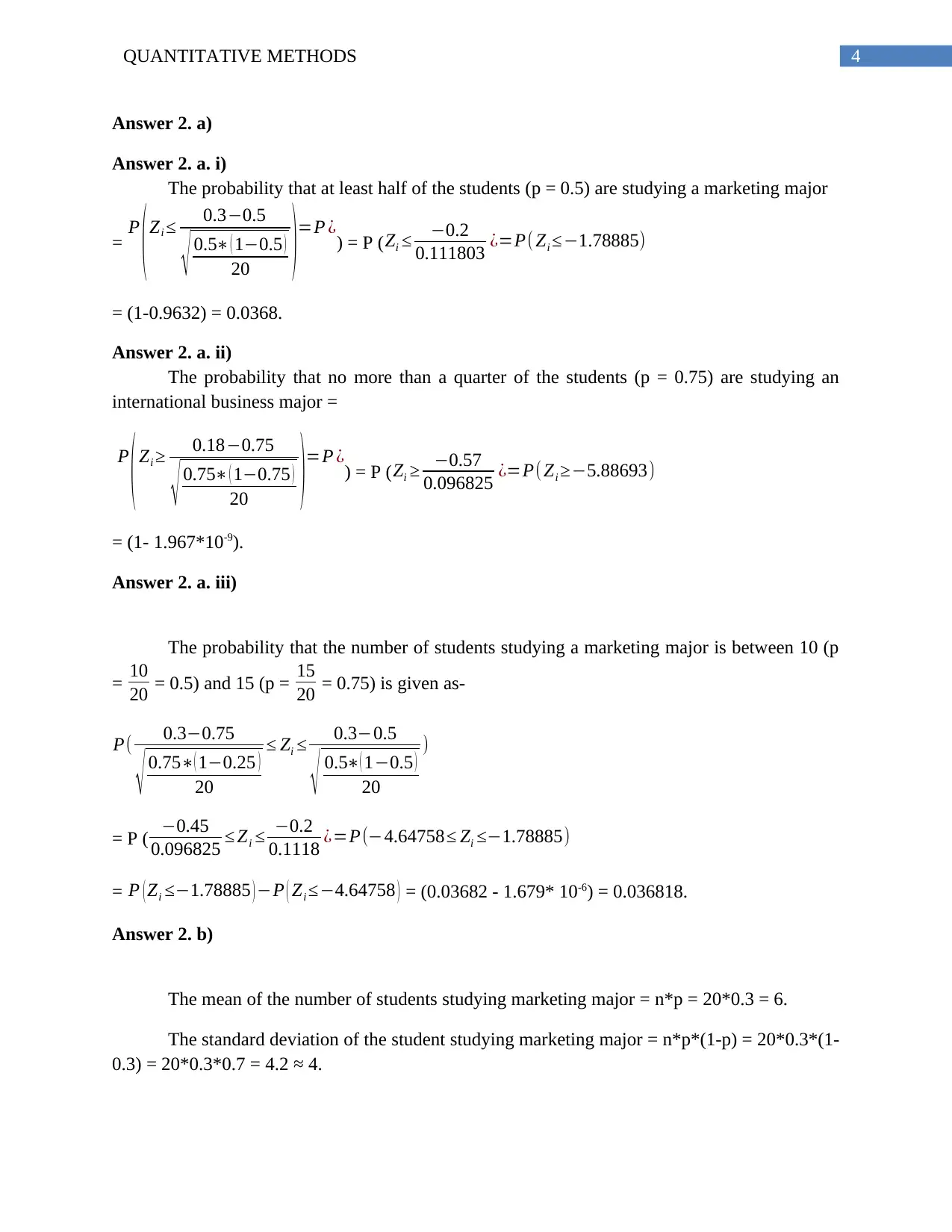
4QUANTITATIVE METHODS
Answer 2. a)
Answer 2. a. i)
The probability that at least half of the students (p = 0.5) are studying a marketing major
= P
(Zi ≤ 0.3−0.5
√ 0.5∗ ( 1−0.5 )
20 )=P ¿) = P ( Zi ≤ −0.2
0.111803 ¿=P( Zi ≤−1.78885)
= (1-0.9632) = 0.0368.
Answer 2. a. ii)
The probability that no more than a quarter of the students (p = 0.75) are studying an
international business major =
P
(Zi ≥ 0.18−0.75
√ 0.75∗ ( 1−0.75 )
20 )=P ¿) = P (Zi ≥ −0.57
0.096825 ¿=P( Zi ≥−5.88693)
= (1- 1.967*10-9).
Answer 2. a. iii)
The probability that the number of students studying a marketing major is between 10 (p
= 10
20 = 0.5) and 15 (p = 15
20 = 0.75) is given as-
P( 0.3−0.75
√ 0.75∗( 1−0.25 )
20
≤ Zi ≤ 0.3−0.5
√ 0.5∗( 1−0.5 )
20
)
= P ( −0.45
0.096825 ≤ Zi ≤ −0.2
0.1118 ¿=P(−4.64758≤ Zi ≤−1.78885)
= P ( Zi ≤−1.78885 ) −P ( Zi ≤−4.64758 ) = (0.03682 - 1.679* 10-6) = 0.036818.
Answer 2. b)
The mean of the number of students studying marketing major = n*p = 20*0.3 = 6.
The standard deviation of the student studying marketing major = n*p*(1-p) = 20*0.3*(1-
0.3) = 20*0.3*0.7 = 4.2 ≈ 4.
Answer 2. a)
Answer 2. a. i)
The probability that at least half of the students (p = 0.5) are studying a marketing major
= P
(Zi ≤ 0.3−0.5
√ 0.5∗ ( 1−0.5 )
20 )=P ¿) = P ( Zi ≤ −0.2
0.111803 ¿=P( Zi ≤−1.78885)
= (1-0.9632) = 0.0368.
Answer 2. a. ii)
The probability that no more than a quarter of the students (p = 0.75) are studying an
international business major =
P
(Zi ≥ 0.18−0.75
√ 0.75∗ ( 1−0.75 )
20 )=P ¿) = P (Zi ≥ −0.57
0.096825 ¿=P( Zi ≥−5.88693)
= (1- 1.967*10-9).
Answer 2. a. iii)
The probability that the number of students studying a marketing major is between 10 (p
= 10
20 = 0.5) and 15 (p = 15
20 = 0.75) is given as-
P( 0.3−0.75
√ 0.75∗( 1−0.25 )
20
≤ Zi ≤ 0.3−0.5
√ 0.5∗( 1−0.5 )
20
)
= P ( −0.45
0.096825 ≤ Zi ≤ −0.2
0.1118 ¿=P(−4.64758≤ Zi ≤−1.78885)
= P ( Zi ≤−1.78885 ) −P ( Zi ≤−4.64758 ) = (0.03682 - 1.679* 10-6) = 0.036818.
Answer 2. b)
The mean of the number of students studying marketing major = n*p = 20*0.3 = 6.
The standard deviation of the student studying marketing major = n*p*(1-p) = 20*0.3*(1-
0.3) = 20*0.3*0.7 = 4.2 ≈ 4.
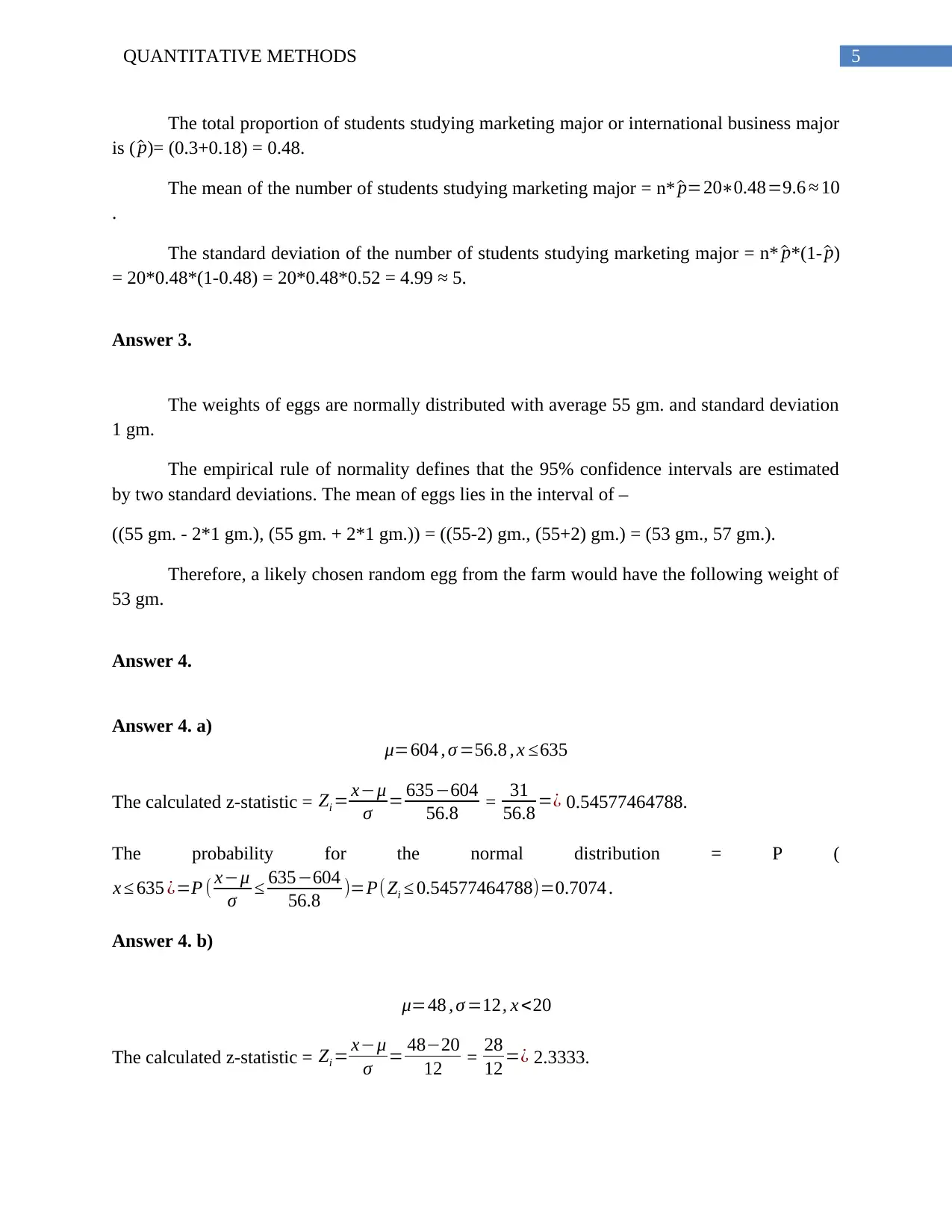
5QUANTITATIVE METHODS
The total proportion of students studying marketing major or international business major
is ( ^p)= (0.3+0.18) = 0.48.
The mean of the number of students studying marketing major = n* ^p=20∗0.48=9.6 ≈ 10
.
The standard deviation of the number of students studying marketing major = n* ^p*(1- ^p)
= 20*0.48*(1-0.48) = 20*0.48*0.52 = 4.99 ≈ 5.
Answer 3.
The weights of eggs are normally distributed with average 55 gm. and standard deviation
1 gm.
The empirical rule of normality defines that the 95% confidence intervals are estimated
by two standard deviations. The mean of eggs lies in the interval of –
((55 gm. - 2*1 gm.), (55 gm. + 2*1 gm.)) = ((55-2) gm., (55+2) gm.) = (53 gm., 57 gm.).
Therefore, a likely chosen random egg from the farm would have the following weight of
53 gm.
Answer 4.
Answer 4. a)
μ=604 , σ =56.8 , x ≤635
The calculated z-statistic = Zi = x−μ
σ = 635−604
56.8 = 31
56.8 =¿ 0.54577464788.
The probability for the normal distribution = P (
x ≤ 635 ¿=P ( x−μ
σ ≤ 635−604
56.8 )=P(Zi ≤ 0.54577464788)=0.7074 .
Answer 4. b)
μ=48 , σ =12, x <20
The calculated z-statistic = Zi = x−μ
σ = 48−20
12 = 28
12 =¿ 2.3333.
The total proportion of students studying marketing major or international business major
is ( ^p)= (0.3+0.18) = 0.48.
The mean of the number of students studying marketing major = n* ^p=20∗0.48=9.6 ≈ 10
.
The standard deviation of the number of students studying marketing major = n* ^p*(1- ^p)
= 20*0.48*(1-0.48) = 20*0.48*0.52 = 4.99 ≈ 5.
Answer 3.
The weights of eggs are normally distributed with average 55 gm. and standard deviation
1 gm.
The empirical rule of normality defines that the 95% confidence intervals are estimated
by two standard deviations. The mean of eggs lies in the interval of –
((55 gm. - 2*1 gm.), (55 gm. + 2*1 gm.)) = ((55-2) gm., (55+2) gm.) = (53 gm., 57 gm.).
Therefore, a likely chosen random egg from the farm would have the following weight of
53 gm.
Answer 4.
Answer 4. a)
μ=604 , σ =56.8 , x ≤635
The calculated z-statistic = Zi = x−μ
σ = 635−604
56.8 = 31
56.8 =¿ 0.54577464788.
The probability for the normal distribution = P (
x ≤ 635 ¿=P ( x−μ
σ ≤ 635−604
56.8 )=P(Zi ≤ 0.54577464788)=0.7074 .
Answer 4. b)
μ=48 , σ =12, x <20
The calculated z-statistic = Zi = x−μ
σ = 48−20
12 = 28
12 =¿ 2.3333.
You're viewing a preview
Unlock full access by subscribing today!
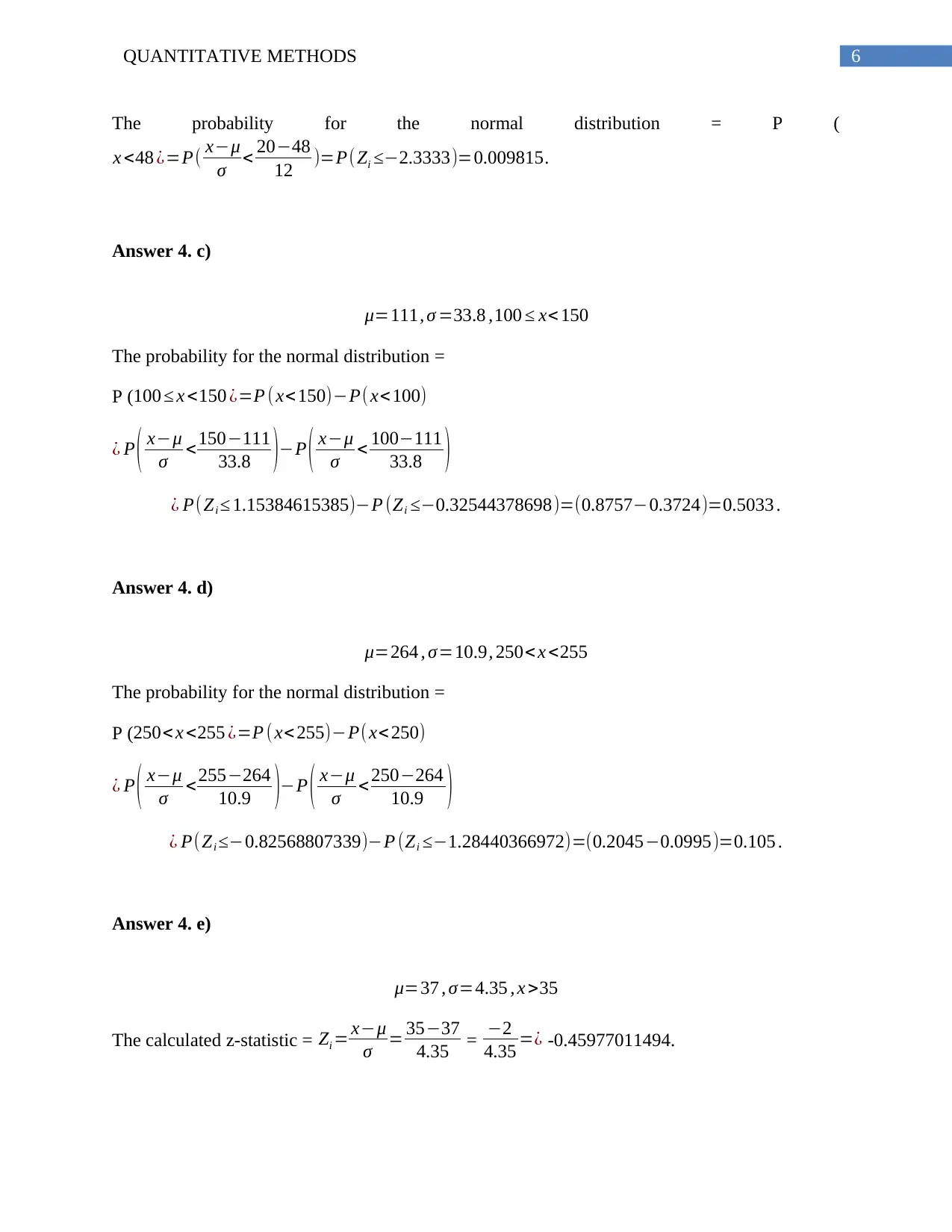
6QUANTITATIVE METHODS
The probability for the normal distribution = P (
x <48 ¿=P( x−μ
σ < 20−48
12 )=P(Zi ≤−2.3333)=0.009815.
Answer 4. c)
μ=111, σ =33.8 ,100 ≤ x< 150
The probability for the normal distribution =
P (100 ≤ x <150 ¿=P (x<150)−P(x<100)
¿ P ( x−μ
σ <150−111
33.8 )−P ( x−μ
σ < 100−111
33.8 )
¿ P(Zi ≤ 1.15384615385)−P (Zi ≤−0.32544378698)=(0.8757−0.3724)=0.5033 .
Answer 4. d)
μ=264 , σ=10.9, 250<x <255
The probability for the normal distribution =
P (250< x <255 ¿=P (x< 255)−P( x<250)
¿ P ( x−μ
σ <255−264
10.9 )−P ( x−μ
σ < 250−264
10.9 )
¿ P(Zi ≤−0.82568807339)−P (Zi ≤−1.28440366972)=(0.2045−0.0995)=0.105 .
Answer 4. e)
μ=37 , σ=4.35 , x >35
The calculated z-statistic = Zi = x−μ
σ = 35−37
4.35 = −2
4.35 =¿ -0.45977011494.
The probability for the normal distribution = P (
x <48 ¿=P( x−μ
σ < 20−48
12 )=P(Zi ≤−2.3333)=0.009815.
Answer 4. c)
μ=111, σ =33.8 ,100 ≤ x< 150
The probability for the normal distribution =
P (100 ≤ x <150 ¿=P (x<150)−P(x<100)
¿ P ( x−μ
σ <150−111
33.8 )−P ( x−μ
σ < 100−111
33.8 )
¿ P(Zi ≤ 1.15384615385)−P (Zi ≤−0.32544378698)=(0.8757−0.3724)=0.5033 .
Answer 4. d)
μ=264 , σ=10.9, 250<x <255
The probability for the normal distribution =
P (250< x <255 ¿=P (x< 255)−P( x<250)
¿ P ( x−μ
σ <255−264
10.9 )−P ( x−μ
σ < 250−264
10.9 )
¿ P(Zi ≤−0.82568807339)−P (Zi ≤−1.28440366972)=(0.2045−0.0995)=0.105 .
Answer 4. e)
μ=37 , σ=4.35 , x >35
The calculated z-statistic = Zi = x−μ
σ = 35−37
4.35 = −2
4.35 =¿ -0.45977011494.
Paraphrase This Document
Need a fresh take? Get an instant paraphrase of this document with our AI Paraphraser
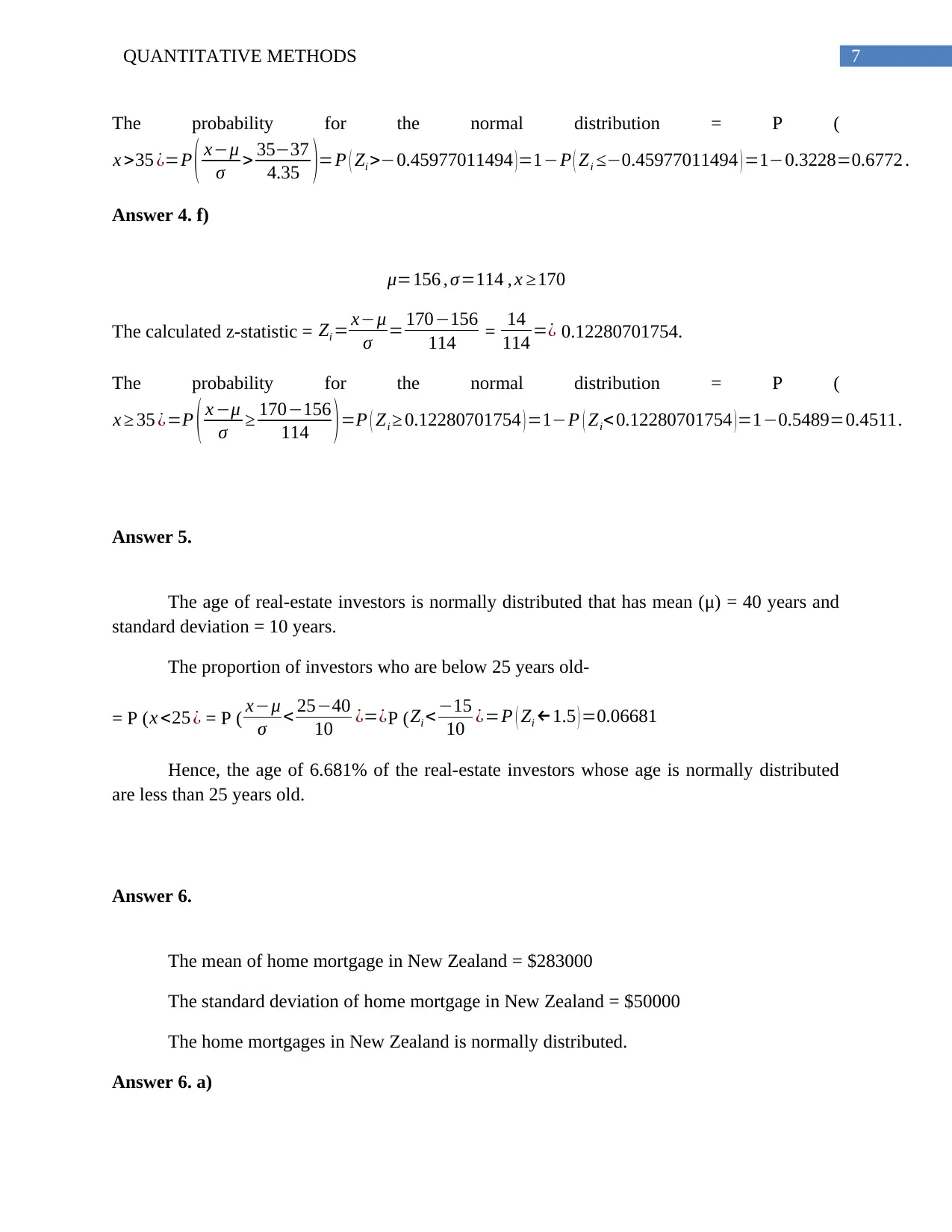
7QUANTITATIVE METHODS
The probability for the normal distribution = P (
x >35 ¿=P ( x−μ
σ > 35−37
4.35 )=P ( Zi >−0.45977011494 )=1−P ( Zi ≤−0.45977011494 ) =1−0.3228=0.6772 .
Answer 4. f)
μ=156 , σ=114 , x ≥170
The calculated z-statistic = Zi = x−μ
σ = 170−156
114 = 14
114 =¿ 0.12280701754.
The probability for the normal distribution = P (
x ≥ 35 ¿=P ( x −μ
σ ≥ 170−156
114 )=P ( Zi ≥ 0.12280701754 ) =1−P ( Zi<0.12280701754 )=1−0.5489=0.4511.
Answer 5.
The age of real-estate investors is normally distributed that has mean (μ) = 40 years and
standard deviation = 10 years.
The proportion of investors who are below 25 years old-
= P ( x <25 ¿ = P ( x−μ
σ < 25−40
10 ¿=¿P (Zi < −15
10 ¿=P ( Zi ←1.5 ) =0.06681
Hence, the age of 6.681% of the real-estate investors whose age is normally distributed
are less than 25 years old.
Answer 6.
The mean of home mortgage in New Zealand = $283000
The standard deviation of home mortgage in New Zealand = $50000
The home mortgages in New Zealand is normally distributed.
Answer 6. a)
The probability for the normal distribution = P (
x >35 ¿=P ( x−μ
σ > 35−37
4.35 )=P ( Zi >−0.45977011494 )=1−P ( Zi ≤−0.45977011494 ) =1−0.3228=0.6772 .
Answer 4. f)
μ=156 , σ=114 , x ≥170
The calculated z-statistic = Zi = x−μ
σ = 170−156
114 = 14
114 =¿ 0.12280701754.
The probability for the normal distribution = P (
x ≥ 35 ¿=P ( x −μ
σ ≥ 170−156
114 )=P ( Zi ≥ 0.12280701754 ) =1−P ( Zi<0.12280701754 )=1−0.5489=0.4511.
Answer 5.
The age of real-estate investors is normally distributed that has mean (μ) = 40 years and
standard deviation = 10 years.
The proportion of investors who are below 25 years old-
= P ( x <25 ¿ = P ( x−μ
σ < 25−40
10 ¿=¿P (Zi < −15
10 ¿=P ( Zi ←1.5 ) =0.06681
Hence, the age of 6.681% of the real-estate investors whose age is normally distributed
are less than 25 years old.
Answer 6.
The mean of home mortgage in New Zealand = $283000
The standard deviation of home mortgage in New Zealand = $50000
The home mortgages in New Zealand is normally distributed.
Answer 6. a)
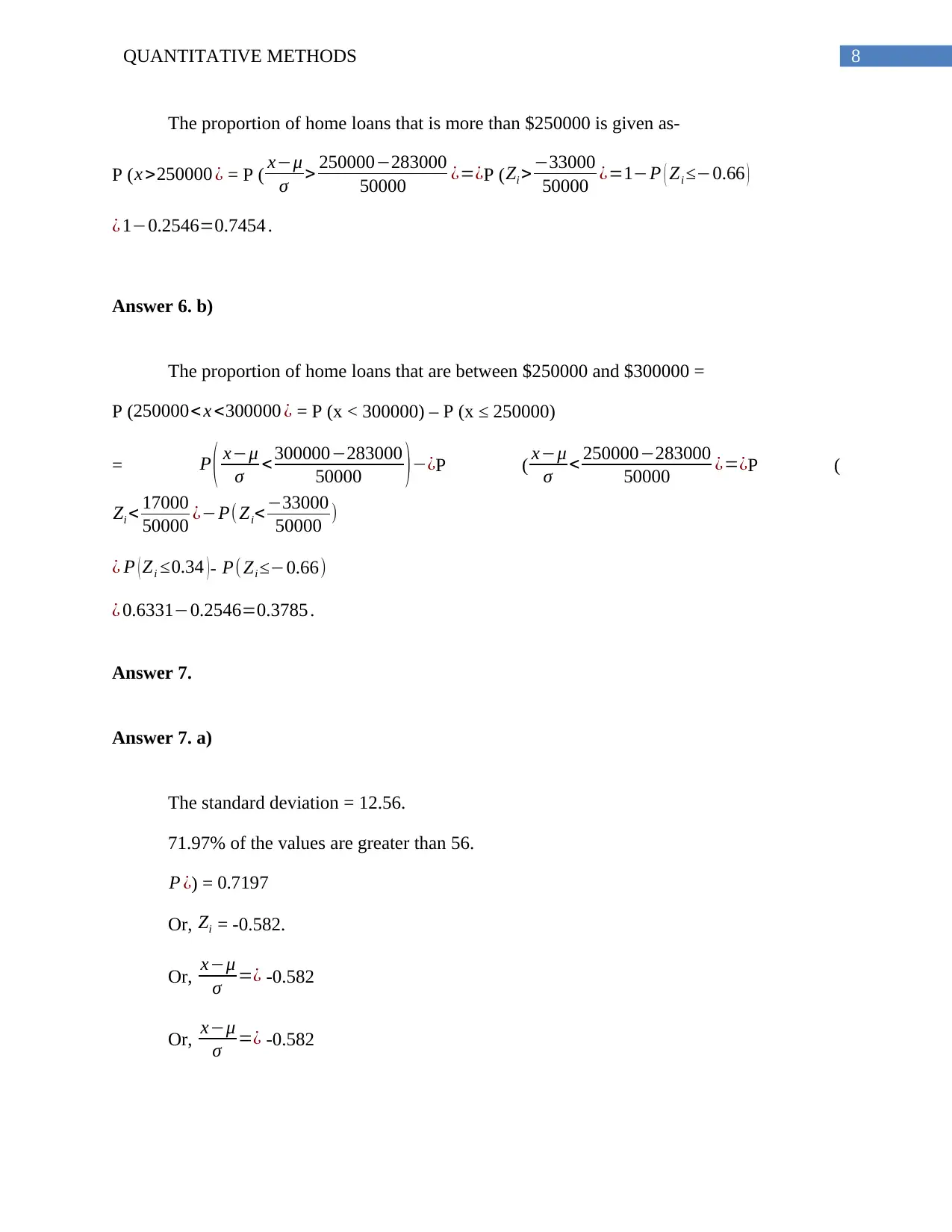
8QUANTITATIVE METHODS
The proportion of home loans that is more than $250000 is given as-
P (x >250000 ¿ = P ( x−μ
σ > 250000−283000
50000 ¿=¿P ( Zi >−33000
50000 ¿=1−P ( Zi ≤−0.66 )
¿ 1−0.2546=0.7454 .
Answer 6. b)
The proportion of home loans that are between $250000 and $300000 =
P (250000< x <300000 ¿ = P (x < 300000) – P (x ≤ 250000)
= P ( x−μ
σ < 300000−283000
50000 )−¿P ( x−μ
σ < 250000−283000
50000 ¿=¿P (
Zi < 17000
50000 ¿−P( Zi< −33000
50000 )
¿ P ( Zi ≤0.34 )- P( Zi ≤−0.66)
¿ 0.6331−0.2546=0.3785 .
Answer 7.
Answer 7. a)
The standard deviation = 12.56.
71.97% of the values are greater than 56.
P ¿) = 0.7197
Or, Zi = -0.582.
Or, x−μ
σ =¿ -0.582
Or, x−μ
σ =¿ -0.582
The proportion of home loans that is more than $250000 is given as-
P (x >250000 ¿ = P ( x−μ
σ > 250000−283000
50000 ¿=¿P ( Zi >−33000
50000 ¿=1−P ( Zi ≤−0.66 )
¿ 1−0.2546=0.7454 .
Answer 6. b)
The proportion of home loans that are between $250000 and $300000 =
P (250000< x <300000 ¿ = P (x < 300000) – P (x ≤ 250000)
= P ( x−μ
σ < 300000−283000
50000 )−¿P ( x−μ
σ < 250000−283000
50000 ¿=¿P (
Zi < 17000
50000 ¿−P( Zi< −33000
50000 )
¿ P ( Zi ≤0.34 )- P( Zi ≤−0.66)
¿ 0.6331−0.2546=0.3785 .
Answer 7.
Answer 7. a)
The standard deviation = 12.56.
71.97% of the values are greater than 56.
P ¿) = 0.7197
Or, Zi = -0.582.
Or, x−μ
σ =¿ -0.582
Or, x−μ
σ =¿ -0.582
You're viewing a preview
Unlock full access by subscribing today!
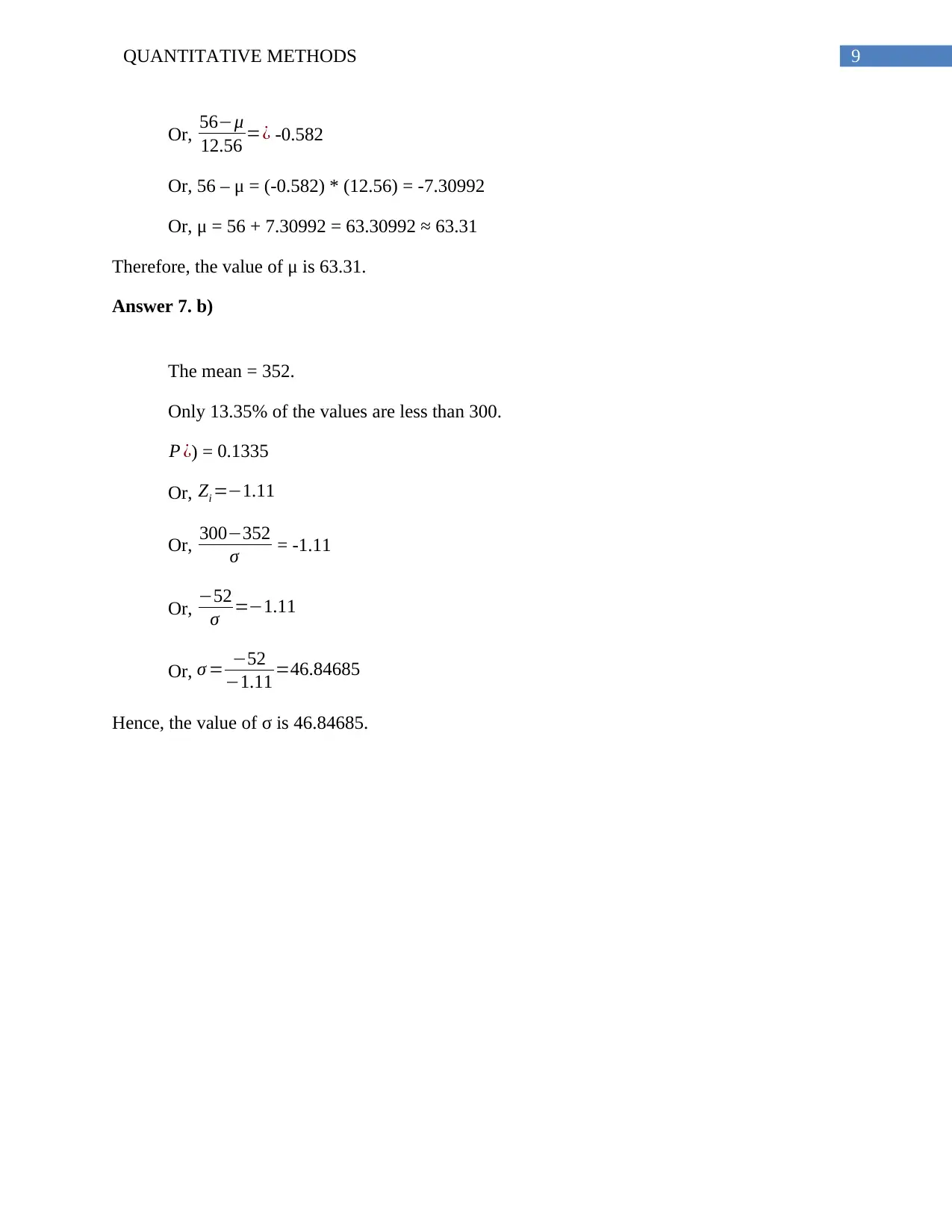
9QUANTITATIVE METHODS
Or, 56−μ
12.56 =¿ -0.582
Or, 56 – μ = (-0.582) * (12.56) = -7.30992
Or, μ = 56 + 7.30992 = 63.30992 ≈ 63.31
Therefore, the value of μ is 63.31.
Answer 7. b)
The mean = 352.
Only 13.35% of the values are less than 300.
P ¿) = 0.1335
Or, Zi =−1.11
Or, 300−352
σ = -1.11
Or, −52
σ =−1.11
Or, σ = −52
−1.11 =46.84685
Hence, the value of σ is 46.84685.
Or, 56−μ
12.56 =¿ -0.582
Or, 56 – μ = (-0.582) * (12.56) = -7.30992
Or, μ = 56 + 7.30992 = 63.30992 ≈ 63.31
Therefore, the value of μ is 63.31.
Answer 7. b)
The mean = 352.
Only 13.35% of the values are less than 300.
P ¿) = 0.1335
Or, Zi =−1.11
Or, 300−352
σ = -1.11
Or, −52
σ =−1.11
Or, σ = −52
−1.11 =46.84685
Hence, the value of σ is 46.84685.
1 out of 10
Related Documents
Your All-in-One AI-Powered Toolkit for Academic Success.
+13062052269
info@desklib.com
Available 24*7 on WhatsApp / Email
![[object Object]](/_next/static/media/star-bottom.7253800d.svg)
Unlock your academic potential
© 2024 | Zucol Services PVT LTD | All rights reserved.





